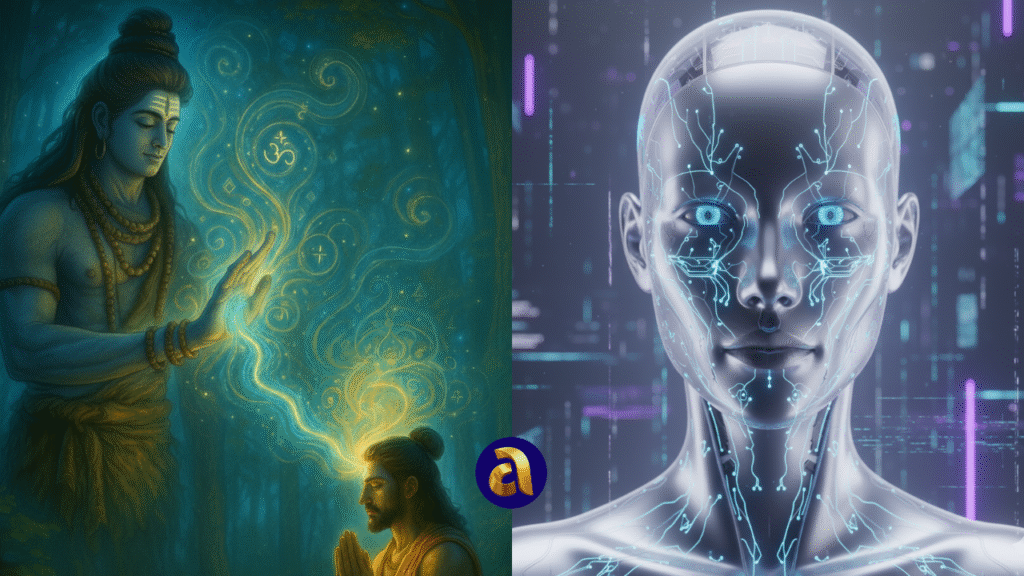When we hear the term Artificial Intelligence (AI) today, we immediately think of platforms like ChatGPT and Gemini, Tesla’s self-driving cars, or the futuristic smart robots we see in labs and movies. The image that comes to our mind is that of a machine that can talk to us, think like us, and perhaps even keep us company in moments of loneliness.
But here is a fascinating truth: the human dream of creating an intelligent companion is not new at all. In fact, it is a vision that goes back thousands of years, deeply rooted in mythology, folklore, and early scientific imagination. What we call “AI” today is simply the modern continuation of an age-old human aspiration.
We are going to publish a series of articles on Artificial Intelligence. This first article tells how the dream of making intelligent machines started in ancient stories, grew with medieval inventions, and is becoming real in today’s AI.
In this article, we will take a fascinating journey from mythology to the modern world. Our timeline unfolds as follows:
- Ramayana Era – around 7,000 years ago
- Mahabharata Era – around 5,000 years ago
- Greek Mythological Stories – around 3,000 years ago
- Ancient China – around 3,000 years ago
- Medieval Arab World – 12th century
- Leonardo da Vinci – 16th century
- Alan Turing – 1950
- John McCarthy (1956)
AI in Ancient India: Divine Weapons and Smart Machines
The Ramayana Era – Believed to be around 7,000 Years Ago
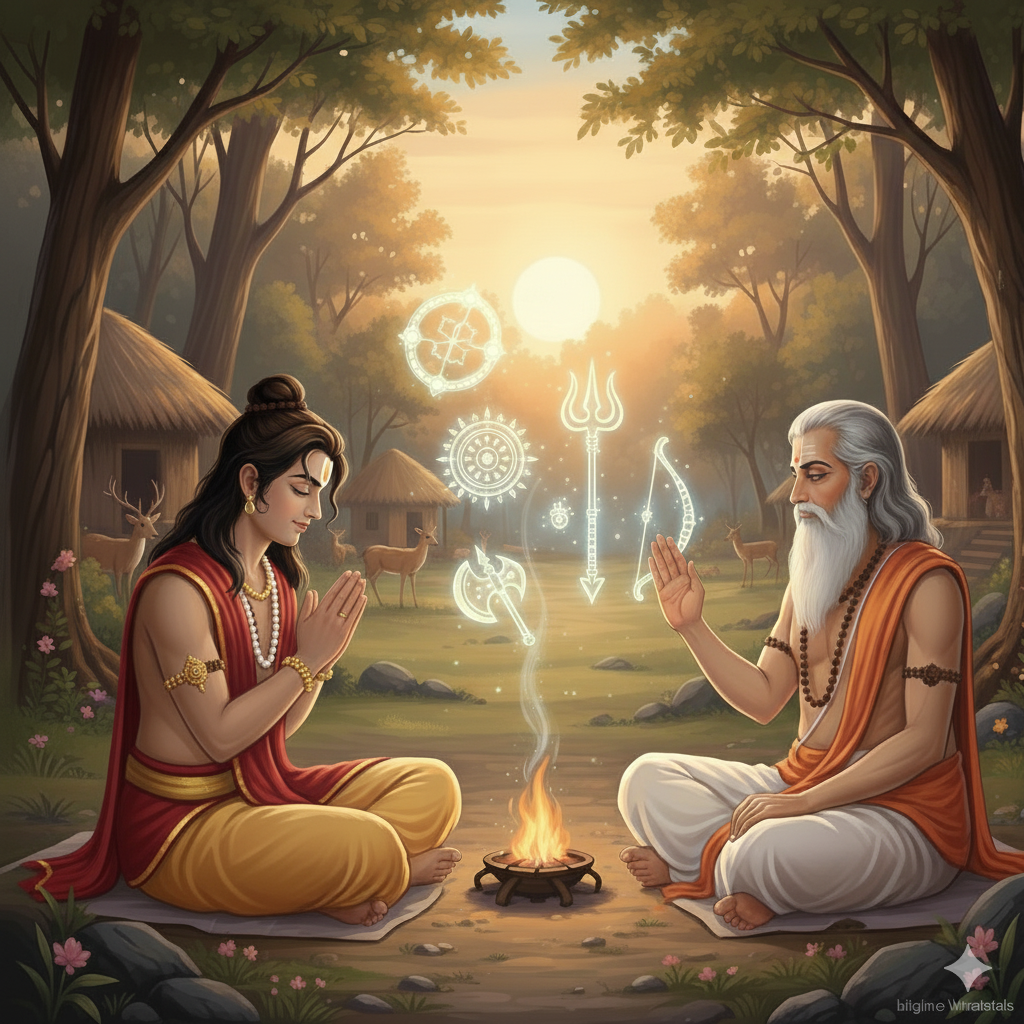
Let us journey to the time of the Ramayana, one of the greatest Indian epics.
When Lord Rama and his younger brother, Lakshmana, accompanied Sage Vishwamitra to guard his sacred ritual (yajna), Vishwamitra gifted Rama a collection of Divyastras—divine weapons of unimaginable power.
Smart Weapons in Valmiki’s Ramayana
In the Bala Kanda of Valmiki’s Ramayana, these weapons are described in detail. Vishwamitra taught Rama two categories of knowledge:
- Mantra Vidya – the knowledge of sacred chants.
- Astra Vidya – the knowledge of celestial weapons.
According to Valmiki Ramayan, when Vishwamitra gives the mantras to Rama, all the weapons appear before him in their celestial forms.
The epic states that they were ready to obey his commands.
“We are ready to serve you, O Mighty One. Just call us, and we will perform whatever task you wish. We will go wherever you command.”
(Sarga 27, Verse 4, Balkand)
Some of these legendary weapons include:
Chakras:
Vishnu Chakra (Vishnu’s Discus) –
A rotating, razor-sharp weapon that could destroy enemies instantly and return to the wielder. Considered one of the most powerful divine tools of Lord Vishnu.
Kala Chakra (Wheel of Time) – Symbolic of time’s unstoppable force, this weapon could paralyze or destroy anything, representing the inevitable power of destiny.
Astras (Missiles):
Brahmastra – Known as the ultimate weapon of Lord Brahma, it could cause massive destruction, similar to today’s nuclear weapons. It was said to destroy not only armies but even entire regions if invoked fully.
Vaishnavastra – Associated with Lord Vishnu, it had the power to counter the Brahmastra. It was believed to protect the wielder from even the deadliest attacks.
Agneyastra (Weapon of Fire) – Once invoked, it released unstoppable flames that could consume armies and dry rivers, behaving like an advanced incendiary missile.
Shaktis (Powers):
Narayanastra – Fired thousands of powerful weapons at once, targeting anyone who opposed the wielder. However, it spared those who surrendered, showing its intelligence and discrimination.
Shirastra (Head-Seeking Weapon) – This Astra specifically targeted the heads of enemies, making it precise and lethal—similar to a guided sniper missile.
Why can we call them “smart weapons”?
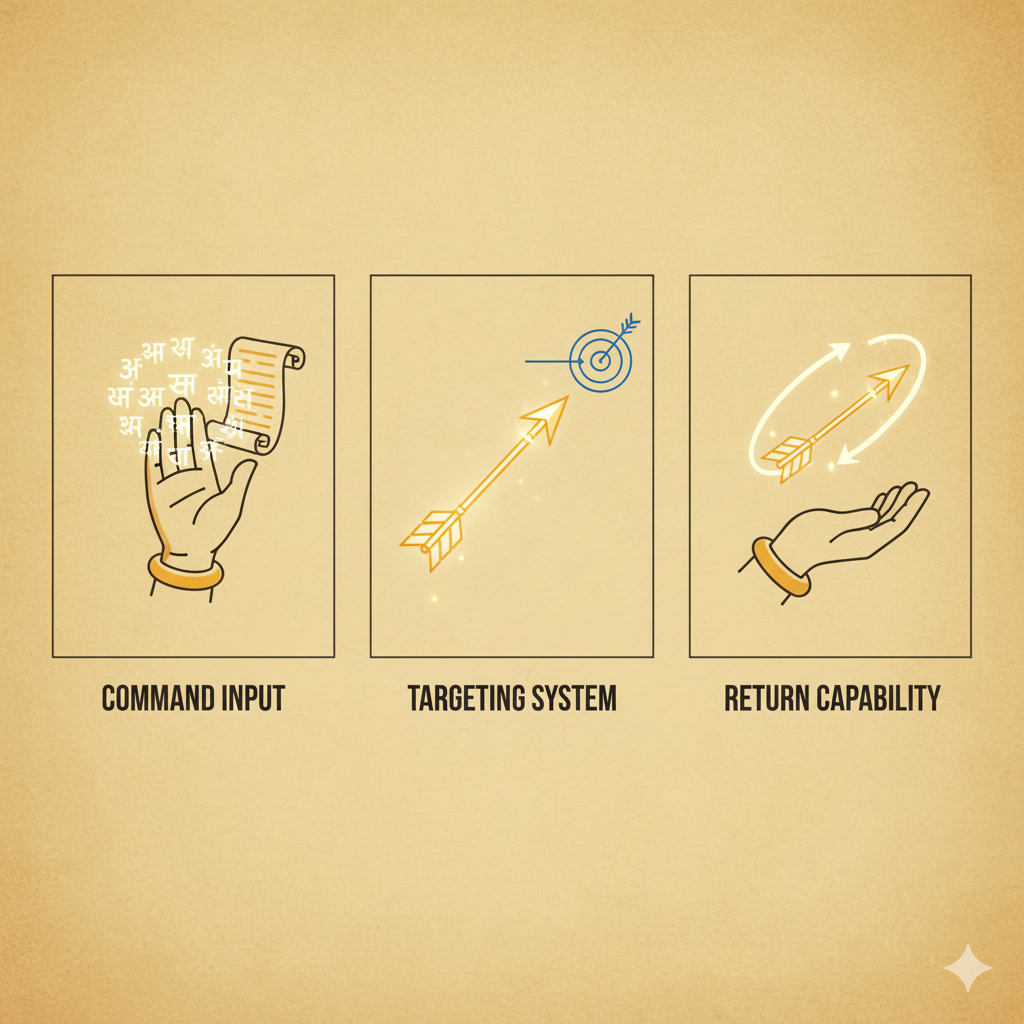
Mantra-operated – They were activated by specific chants, much like entering a command in a software program.
Targeted and Autonomous: Once invoked, they did not require human control—they found their targets on their own.
Return Capability – After completing their mission, they would return to the wielder, just like today’s reusable drones or guided missiles.
If we think in today’s terms, these astras resembled AI-powered precision weapons, programmed to perform tasks intelligently.
The Mahabharata Era – Believed to be around 5,000 Years Ago
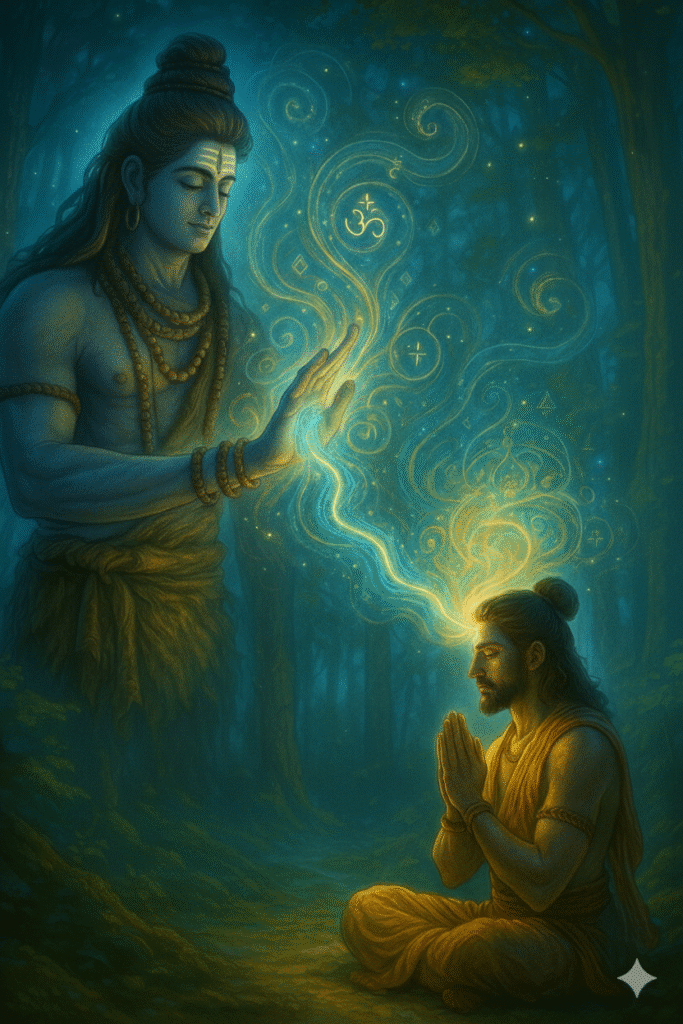
Let us now journey to the era of the Mahabharata, the legendary epic that narrates the great Kurukshetra War, said to have taken place some 5,000 years ago.
Imagine the astonishment of modern military commanders if they could witness that time, beholding weapons that seemed almost alive, striking their targets and adapting on their own, much like the intelligent machines of today.
Some striking examples include:
Astras (Missiles):
Pashupatastra: The Ultimate “Software” Weapon
According to the Mahabharata epic, the Pashupatastra was a devastating power bestowed upon the great warrior Arjuna by the grace of Lord Shiva. This was no ordinary weapon; it was a non-physical force that Arjuna had imbibed within his being.
Thus the power became a part of Arjuna’s very being—a part of his consciousness and will—to be activated whenever he chose.
In a way, the Pashupatastra was a form of ancient software. It wasn’t launched like a physical arrow, but rather manifested as a terrifying energy through a sacred mantra and the wielder’s will. The mantra acted as the command line, and the wielder’s mind served as the processor.
Once activated, the astra became a fully autonomous program, finding its target on its own to ensure complete annihilation.
Arjuna never used the Pashupatastra in the Kurukshetra war, for it was not a physical weapon but a divine energy — a conscious power granted by Lord Shiva, residing within Arjuna’s will.
Narayanastra in the Mahabharata — A Refined Form
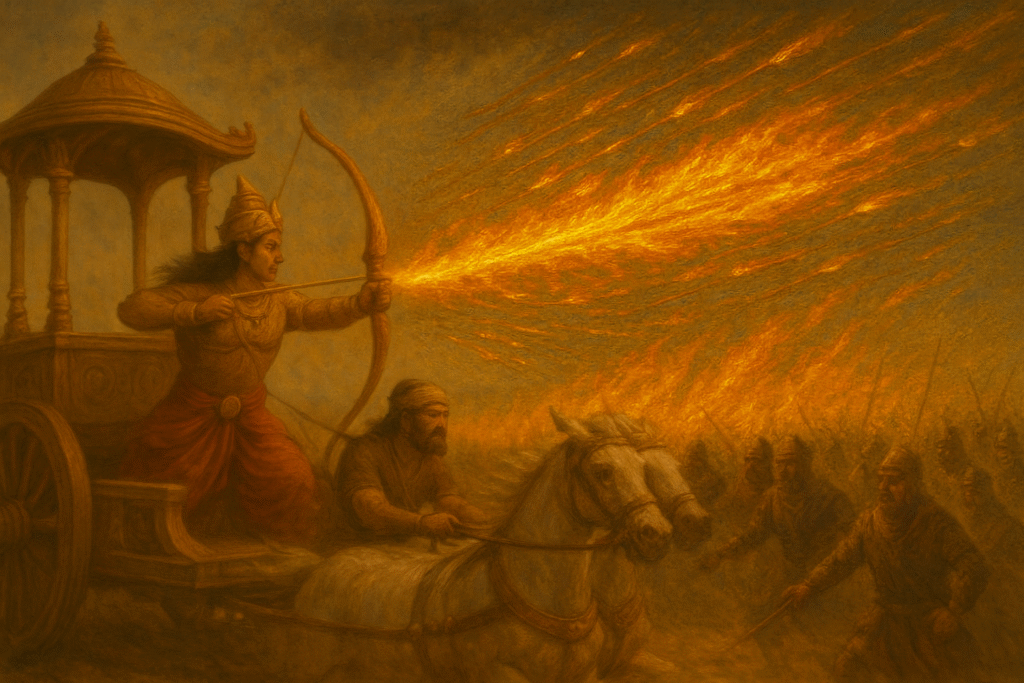
The reference of Narayanastra is found in the stories of both the Ramayan era and the Mahabharat era.
But it seems that by the time of the Mahabharata, Narayanastra appears in a far more refined and adaptive form.
When Ashwatthama invoked it against the Pandava army, the weapon displayed extraordinary intelligence. It released countless projectiles that multiplied with resistance: the more soldiers fought back, the stronger it became.
Most remarkably, it could discriminate between combatants and non-combatants—sparing those who surrendered or dropped their weapons, while annihilating those who continued to resist.
This was not merely a destructive force; it was a self-adapting, almost sentient weapon that assessed battlefield conditions and acted accordingly. In modern terms, it resembled an AI-powered autonomous defense system—capable of targeting, escalation, and ethical selectivity.
Clearly, the imagination of AI-like systems existed in India thousands of years before the modern world coined the term “Artificial Intelligence.”
From Myth to Modernity — Technological Evolution
The progression of the Narayanastra from the Ramayana to the Mahabharata almost mirrors the evolution of technology over time.
In the Ramayana, it was a raw, overwhelming force of destruction—much like the early stages of technology, powerful but unrefined. By the Mahabharata, it had become a sophisticated, intelligent system—much like today’s AI, which can analyze, decide, and act with precision.
According to renowned scientist and historian Subhash Kak,
“The divine weapons of the epics were not just arrows. They were more like intelligent machines, programmed by mantras, that could be controlled from a distance.”
(Reference: The Architecture of Knowledge)
This evolution highlights a fascinating parallel: just as human technology grows smarter with each generation, our mythological imagination also depicts divine weapons as becoming increasingly refined, adaptive, and selective.
AI and the Ancient Vision
What our ancients imagined as divyastras can be seen as precursors of modern discussions around AI and autonomous weapons. Just as Narayanastra spared the surrendered, today’s AI researchers explore building ethical algorithms that distinguish between threats and innocents. The caution and reverence our ancestors attached to such weapons remind us of the responsibility that comes with creating powerful technologies.
Ultimately, whether in mythology or in science, the question remains the same: How should we control power that can surpass human capacity?
AI in Global Mythologies
The Greek World – Talos, the Bronze Giant
Now, let’s jump ahead – it’s a world 3,000 years ago.
We are on the island of Crete in ancient Greece.
Imagine, you’re sitting peacefully on the island, and suddenly a sound shakes the earth. You see a bronze giant passing through the coastal area.
You’re both frightened and amazed by the sight.
What is this?
This is Talos.
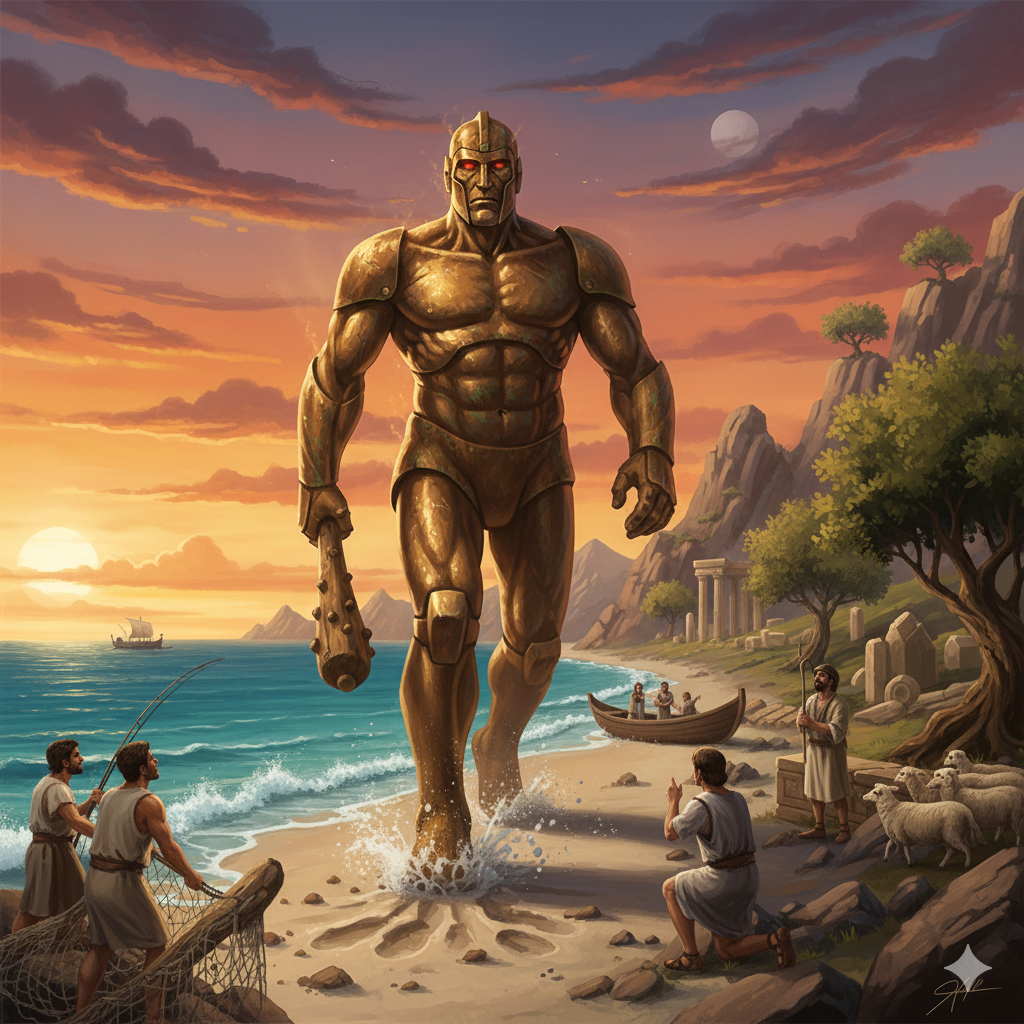
According to Greek mythology, Talos – the bronze giant – was actually a machine crafted by the god Hephaestus as an early form of a self-propelled protector.
Tasked with a singular purpose, Talos patrolled the island’s shores, circling the entire coast three times a day to deter any threat with his imposing presence.
The story of this bronze giant shows that from the earliest times, humanity has dreamed of building self-operating machines for its protection.
In many ways, Talos was an ancient form of today’s autonomous surveillance and defense systems—a sentinel patrolling an entire territory much like a modern-day satellite or security drone.
Ancient China – Yan Shi’s Mechanical Man
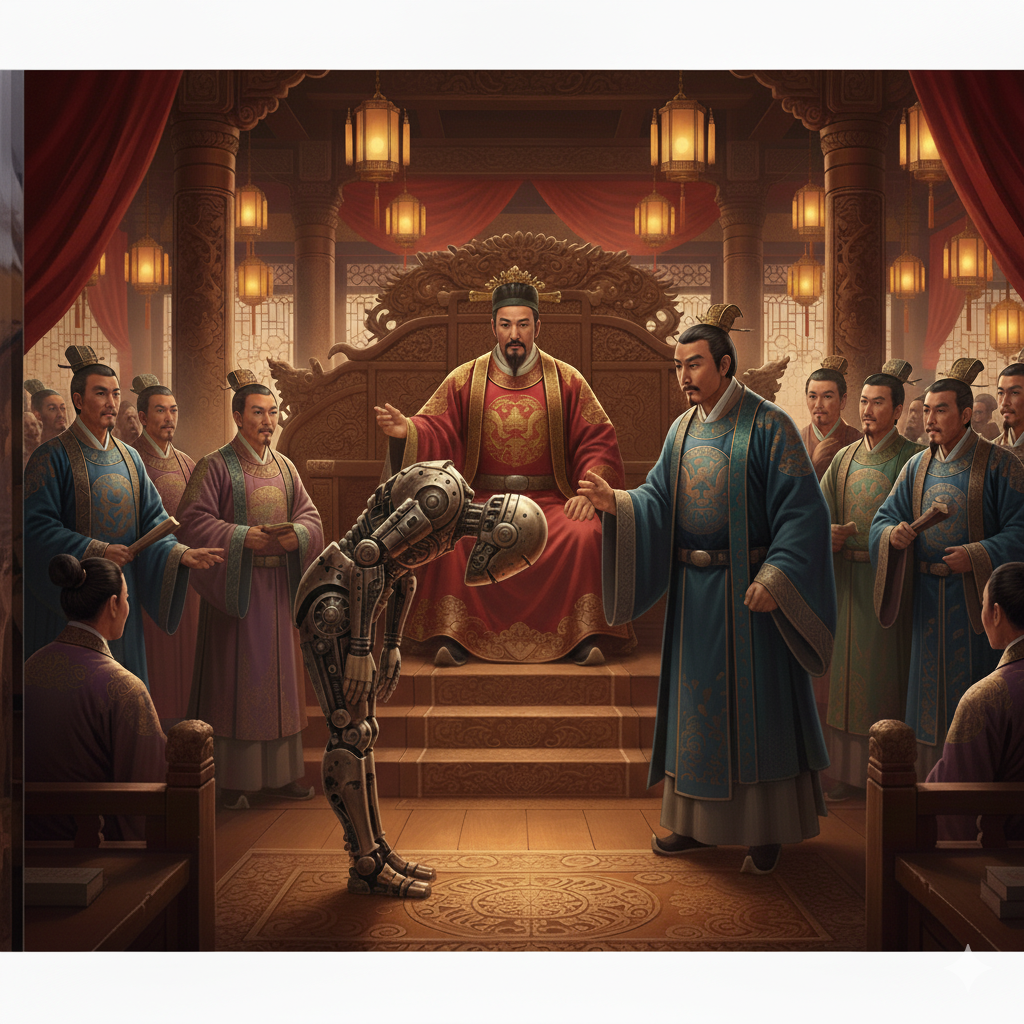
Around the same period in ancient China, there lived a craftsman named Yan Shi. According to Chinese legends, Yan Shi built a humanoid robot for King Mu of Zhou.
This mechanical man could walk, dance, and sing, astonishing the royal court. When dismantled, it revealed an intricate system of leather, wood, and gears—perhaps the earliest description of a life-like android.
These stories show that the imagination of intelligent machines was universal, spanning cultures across the world.
The Medieval Islamic World – Al-Jazari, Father of Robotics
As history moved into the Middle Ages, the Arab world became a center of learning and innovation. In the 12th century, a brilliant inventor named Al-Jazari emerged, often hailed as the Father of Robotics.
Donald R. Hill, a renowned authority on Al-Jazari’s work, describes his work as a unique masterpiece of practical engineering.
According to Hill,
“It is impossible to over-emphasize the importance of al-Jazari’s work in the history of engineering. Until modern times there is no other document from any cultural area that provides a comparable wealth of instructions for the design, manufacture and assembly of machines.”
Who Was Al-Jazari?
His full name was Badiʿ al-Zaman Abu al-ʿIzz ibn Ismaʿil ibn al-Razzaz al-Jazari. He lived from 1136 to 1206 CE and worked as the chief engineer in Mesopotamia (modern-day Turkey).
His Masterpieces
Automata – He designed humanoid robots, including a robotic musical band with four performers powered by water, and even a robot that served drinks to guests.
The Elephant Clock – His most famous invention—a grand clock featuring elephants, dragons, humans, and birds. It was not just a timekeeping device but also a work of art, with moving robotic figures powered by hydraulics.
Crankshaft – Al-Jazari is credited with designing the earliest known crankshaft, a critical component still used in modern engines.
Other Inventions – Water pumps, combination locks, water-powered machines, and complex clocks.
Unlike myths and legends, Al-Jazari’s inventions were real, practical, and mechanical marvels, documented in his 1206 book ‘The Book of Knowledge of Ingenious Mechanical Devices’. His works influenced European engineering and paved the way for modern robotics.
Renaissance Europe – Leonardo da Vinci’s Vision of Mechanical Life
Leonardo da Vinci (1452 – 1519): The Engineer of Dreams
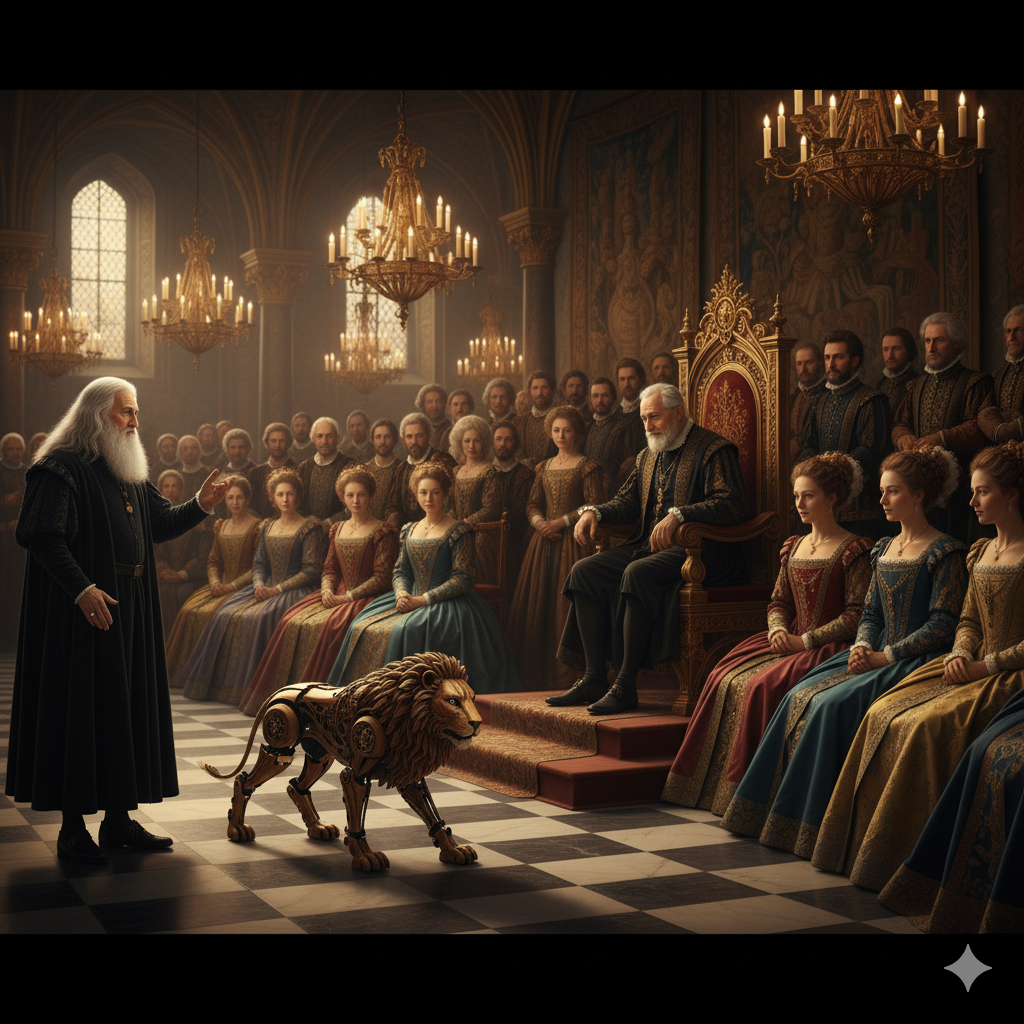
While the world remembers Leonardo da Vinci as a masterful painter of masterpieces like the Mona Lisa, his restless mind was equally fascinated by the inner workings of the universe. Within the pages of his notebooks lay not just sketches of art, but a breathtaking blueprint for a future world.
He was a scientist, engineer, and visionary whose work blurred the lines between mechanics and magic. In his view, a machine was not just a tool; it was an expression of human genius, a performer, and an extension of humanity’s boundless imagination. This section traces his incredible journey as an inventor, from a curious mind to a master of automation.
The Self-Propelled Cart: The First Spark (c. 1478)
The first glimpse into Leonardo’s fascination with autonomy came in his early designs for a self-propelled cart. This vehicle, a precursor to the modern automobile, was not powered by a horse or an engine.
Instead, it was an intricate automaton operated by a clever system of gears and springs hidden beneath its frame. This cart was Leonardo’s earliest step toward building machines that could move on their own, setting him on a path that would lead to even more astounding creations and solidifying his view that machines could be independent.
The Mechanical Knight: A Step into Robotics (c. 1495)
Working in the court of Duke Ludovico Sforza in Milan, Leonardo’s genius evolved from a simple cart to a fully articulated humanoid automaton. Around 1495, he designed the Mechanical Knight, a robot that could sit, stand, and move its arms using a complex system of cables and pulleys. This armored machine was designed to perfectly mimic human motion, a feat that would not be replicated for centuries.
This incredible invention was a testament to his engineering prowess, but it was just a beginning. His relentless pursuit of automated machines would soon take to the skies.
The Flying Machines: A Dream of Flight (c. 1480s-1500s)
Leonardo’s obsession with machines was not limited to the ground. His most ambitious and visionary designs were those for flying machines. In a series of notebooks, he meticulously sketched blueprints for his ornithopter—a giant flying machine with flapping wings—as well as a precursor to the modern helicopter.
Leonardo was the first to study aerodynamics scientifically, believing that if he could unlock the secrets of flight, he could give humanity wings. While these machines were never successfully built in his lifetime, they represented his ultimate dream: to build machines that could not only move on their own but also transcend the very limits of nature.
The Mechanical Lion: The Final Masterpiece (1515)
In 1515, Leonardo’s genius culminated in a breathtaking diplomatic spectacle in the court of King Francis I of France.
There is an often-told story that Leonardo went to the court and, with the royal permission, he unveiled a life-sized lion, a magnificent automaton crafted from wood and iron. While the court watched in awe, Leonardo activated the mechanism. The lion, a tireless, self-operating marvel, began to walk on its own before the king. That was an amazing sight for the king and courtiers.
In a final, climactic act, the lion stopped, opened its chest, and presented a cluster of lilies—the very symbol of the French monarchy.
This stunning, symbolic tribute was a testament to Leonardo’s final vision: a perfect blend of engineering, art, and performance.
In many ways, Leonardo’s work marks the true beginning of modern robotic science, with his mechanical knight and mechanical lion serving as the earliest blueprints for today’s AI-powered machines.
Towards Modern AI – The Scientific Turn
While myths, legends, and inventions sparked the imagination, the scientific era gave AI its modern form.
Alan Turing (1950): proposed the question “Can machines think?” and the famous Turing Test.
John McCarthy (1956): coined the term “Artificial Intelligence,” giving birth to a new discipline.
These pioneers transformed ancient dreams into modern science, opening the path to today’s intelligent machines.
Conclusion:
AI as a Timeless Human Aspiration
Across cultures and centuries—from Indian epics to European Renaissance—humanity has envisioned intelligent companions.
Our study shows that the seeds of modern AI lay hidden in civilizations long past.
AI is the fulfillment of a human dream that has existed for thousands of years: to create machines that can think and act like us.
Today’s artificial intelligence is a technology that makes that ancient dream a reality.
